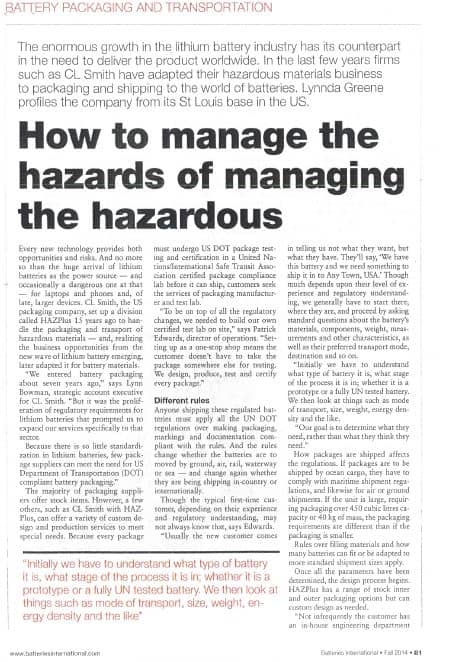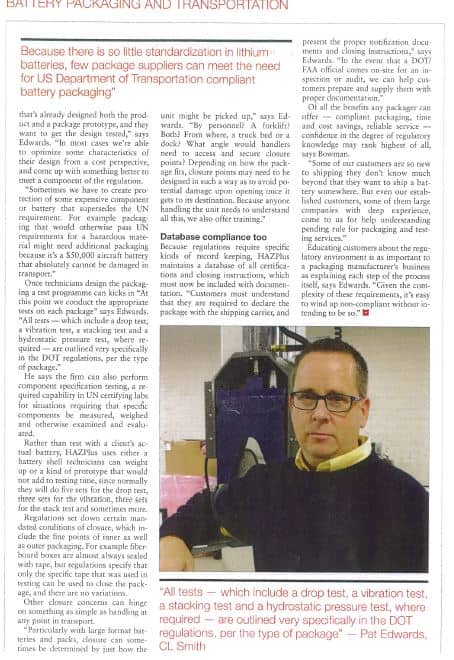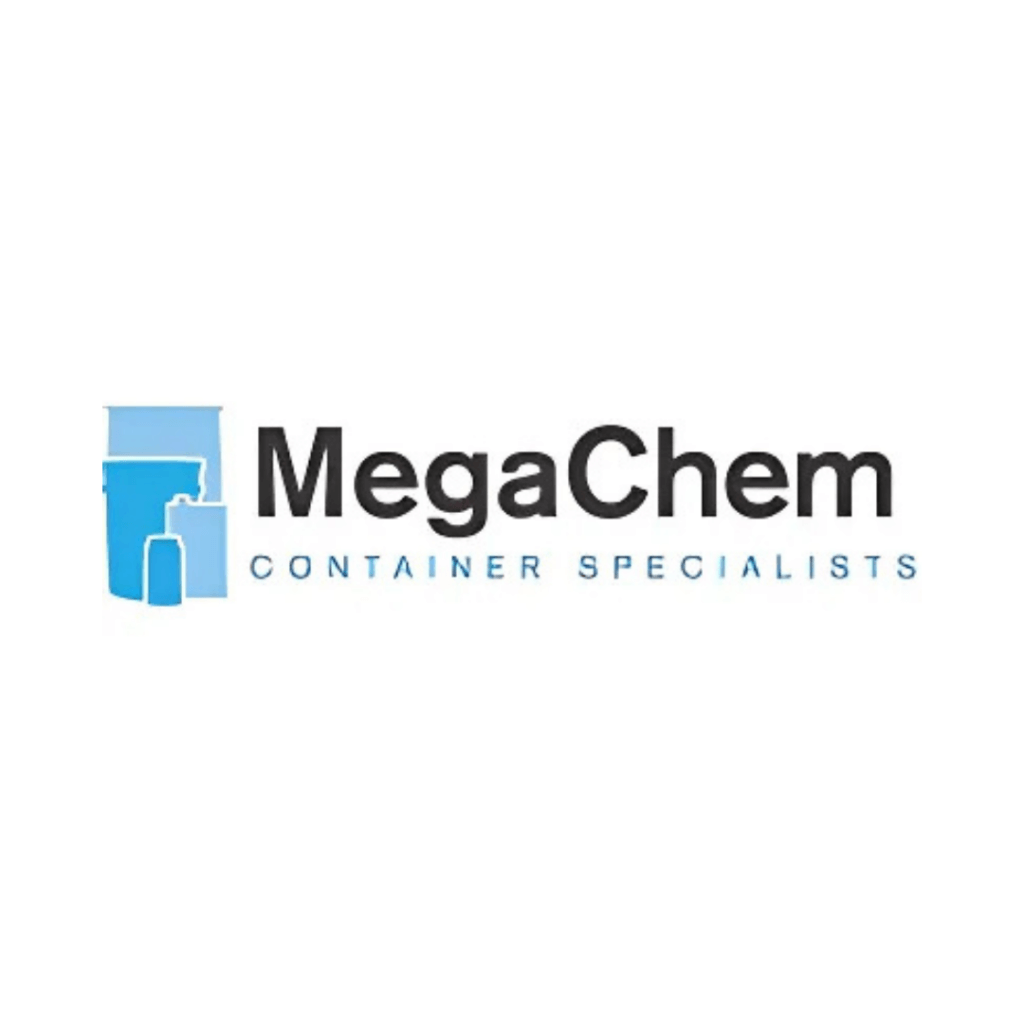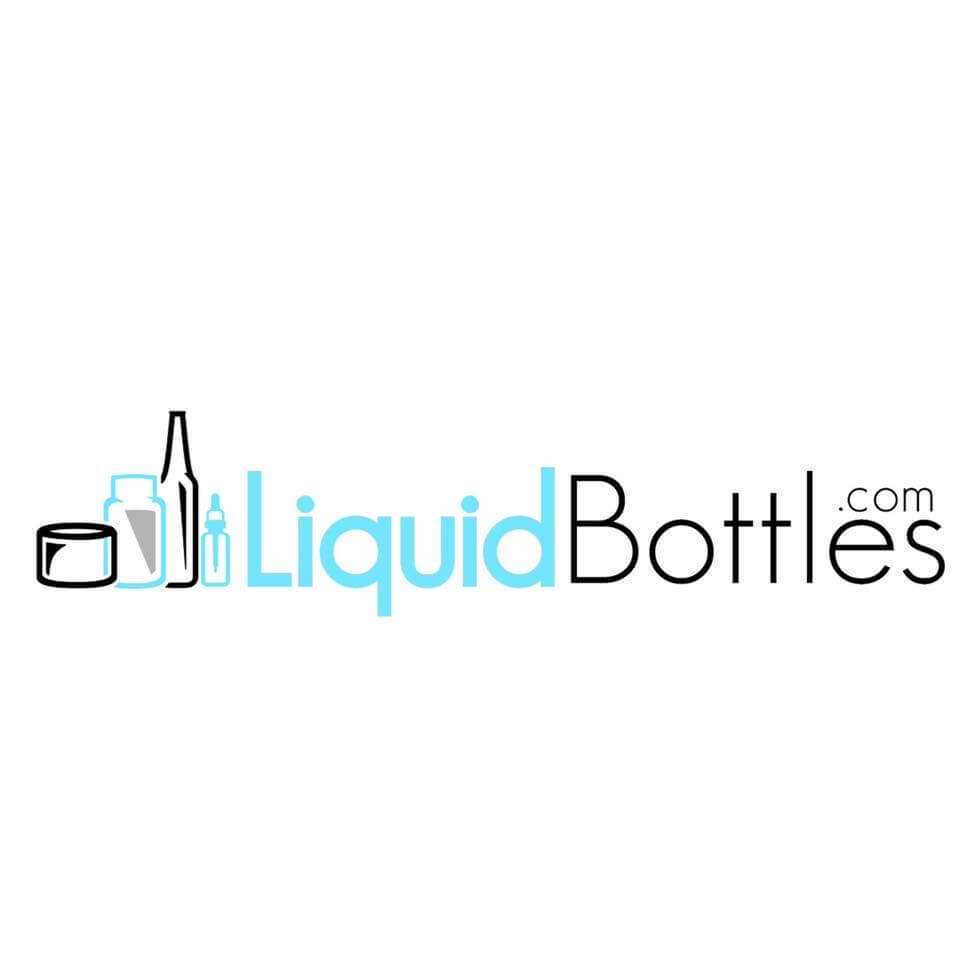C.L. Smith and HAZPlus®Featured in Batteries International Magazine
How To Manage the Hazards of Managing the Hazardous
The enormous growth in the lithium battery industry has its counterpart in the need to deliver the product worldwide. In the past few years firms such as C.L. Smith have adapted their hazardous materials business to packaging and shipping to the world of batteries. Lynnda Greene profiles the company from its St. Louis base in the US.
Every new technology provides both opportunities and risks. And no more so than the huge arrival of lithium batteries as a power source – and occasionally a dangerous one at that – for laptops and phones and, of late, larger devices. C.L. Smith, the US packaging company, set up a division called HAZPlus 15 years ago to handle the packaging and transport of hazardous materials – and, realizing the business opportunities from the new wave of lithium battery emerging, later adapted it for battery materials.
“We entered battery packaging about seven years ago,” says Lynn Bowman, strategic account executive for C.L. Smith. “But it was the proliferation of regulatory requirements for lithium batteries that prompted us to expand our services specifically to that sector. Because there is so little standardization in lithium batteries, few packaging suppliers can meet the need for US Department of Transportation (DOT) compliant battery packaging.”
The majority of packaging suppliers offer stock items. However, a few others, such as C.L. Smith with HAZPlus, can offer a variety of custom design and production services to meet special needs. Because every package must undergo US DOT package testing and certification in a United Nations/International Safe Transit Association certified package compliance lab before it can ship, customers seek the services of packing manufacturer and test lab.
“To be on top of all the regulatory changes, we needed to build our own certified test lab on site,” says Patrick Edwards, director of operations. “Setting up as a one-stop shop means the customer doesn’t have to take the package somewhere else for testing. We design, produce, test and certify every package.”
Different Rules
Anyone shipping these regulated batteries must apply all the UN DOT regulations over making packaging, markings and documentation compliant with the rules. And the rules change whether the batteries are to be moved by ground, air, rail, waterway or sea – and change again whether they are being shipped in-country or internationally.
“Though the typical first-time customer, depending on their experience and regulatory understanding, may not always know that,” says Edwards. “Usually the new customer comes in telling us not what they want, but what they have. They’ll say, ‘We have this battery and need something to ship it in to Any Town, USA.’ Though much depends upon their level of experience and regulatory understanding, we generally have to start there, where they are, and proceed by asking standard questions about the battery’s materials, components, weight, measurements and other characteristics, as well as their preferred transport mode, destination and so on.”
“Initially we have to understand what type of battery it is, what stage of the process it is in; whether it is a prototype or a fully UN tested battery. We then look at things such as mode of transport, size, weight, energy density and the like. Our goal is to determine what they need, rather than what they think they need.”
How packages are shipped affects the regulations. If packages are to be shipped by ocean cargo, they have to comply with maritime shipment regulations, and likewise for air or ground shipments. If the unit is large, requiring packaging over 450 cubic liters capacity or 40 kg of mass, the packaging requirements are different than if the packaging is smaller. Rules over filling materials and how many batteries can fit or be adapted to more standard shipment sizes apply.
Once all the parameters have been determined, the design process begins. HAZPlus has a range of stock inner and outer packaging options but can custom design as needed.
“Not infrequently the customer has an in-house engineering department that’s already designed both the product and the package prototype, and they want to get the design tested,” says Edwards. “In most cases we’re able to optimize some characteristics of their design from a cost perspective, and come up with something better to meet a component of the regulation.”
“Sometimes we have to create protection of some expensive component or battery that supersedes the UN requirement. For example, packaging that would otherwise pass UN requirements for a hazardous material might need additional packaging because it’s a $50,000 aircraft battery that absolutely cannot be damaged in transport.”
Once technicians design the packaging, a test program can kick in. “At this point we conduct the appropriate tests on each package” says Edwards. “All tests – which include a drop test, a vibration test, a stacking test and a hydrostatic pressure test, where required – are outlined very specifically in the DOT regulations, per the type of package.”
He says the firm can also preform component specification testing, a required capability in UN certifying labs for situations requiring that specific components be measured, weighed and otherwise examined and evaluated.
Rather than test with a client’s actual battery, HAZPlus uses either a battery shell technicians can weight up or a kind of prototype that would not add to testing time, since normally they will do five sets for the drop test, three sets for the vibration, three sets for the stack test and sometimes more.
Regulations set down certain mandated conditions of closure, which include the fine points of inner as well as outer packaging. For example, fiberboard boxes are almost always sealed with tape, but regulations specify that only the specific tape that was used in testing can be used to close the package, and there are no variations.
Other closure concerns can hinge on something as simple as handling at any point in transport. “Particularly with large format batteries and packs, closure can sometimes be determined by just how the unit might be picked up,” says Edwards. “By personnel? A forklift? Both? From where, a truck bed or a dock? What angle would the handlers need to access and secure closure points? Depending on how the package fits, closure points may need to be designed in such a way as to avoid potential damage upon opening once it gets to its destination. Because anyone handling the unit needs to understand all of this, we also offer training.”
Database Compliance Too
Because regulations require specific kinds of record keeping, HAZPlus maintains a database of all certifications and closing instructions, which must now be included with documentation. “Customers must understand that they are required to declare the package with the shipping carrier, and present the proper notification documents and closing instructions,” says Edwards. “In the event that a DOT/FAA official comes on-site for an inspection or audit, we can help customers prepare and supply them with proper documentation.”
Of all the benefits any packager can offer – compliant packaging, time and cost savings, reliable service – confidence in the degree of regulatory knowledge may rank highest of all, says Bowman.
“Some of our customers are so new to shipping they don’t know much beyond that they want to ship a battery somewhere. But even our established customers, some of them large companies with deep experience, come to us for help understanding pending rule for packaging and testing services.”
“Educating customers about the regulatory environment is as important to a packaging manufacturer’s business as explaining each step of the process itself,” says Edwards. “Given the complexity of these requirements, it’s easy to wind up non-compliant without intending to be so.”
Click Here to Learn More About Our Lithium Ion Battery Packaging
Comments are closed









